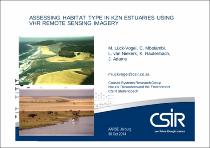JavaScript is disabled for your browser. Some features of this site may not work without it.
- ResearchSpace
- →
- Research Publications/Outputs
- →
- Conference Publications
- →
- View Item
| dc.contributor.author |
Lück-Vogel, Melanie

|
|
| dc.contributor.author |
Mbolambi, Cikizwa

|
|
| dc.contributor.author |
Van Niekerk, Lara

|
|
| dc.contributor.author |
Rautenbach, K

|
|
| dc.contributor.author |
Adams, J

|
|
| dc.date.accessioned | 2017-08-22T13:07:57Z | |
| dc.date.available | 2017-08-22T13:07:57Z | |
| dc.date.issued | 2014-10 | |
| dc.identifier.citation | Lück-Vogel, M., Mbolambi, C., Van Niekerk, L. et al. 2014. Assessing habitat type in KZN estuaries using VHR remote sensing imagery. AARSE Symposium, Johannesburg, 30 Oct 2014 | en_US |
| dc.identifier.uri | http://hdl.handle.net/10204/9451 | |
| dc.description | AARSE Symposium, Johannesburg, 30 Oct 2014 | en_US |
| dc.description.abstract | Within the presented project, we are comparing ecosystem and land cover classifications for the Greater St Lucia region derived from multispectral RapidEye (5m resolution), WorldView-2 (2m resolution), SPOT-6 (5.55m resolution) data with and without the additional use of LiDAR derived elevation data. Aiming for transferability of the classification approach, prior to classification, all images were corrected for atmospheric and radiometric effects. As ground reference, a GIS-derived wetland classification based on site visits and aerial photos from 2013 have been used. The respective wetland classes are aligned with existing habitat keys (e.g. from the South African National Biodiversity Assessment), which will enable implementation of our classification in existing management practices. For non-wetland areas, existing land cover classes from the SPOT-5 based KZN Land Cover from 2008 were used as reference. From both reference data sets, stratified random points for each class were extracted and part of it was used for the training of the classification and the remainder for the validation of the results. The same set of points was used for each satellite classification. This allowed an unbiased comparison of the classification results. Classification algorithms used are Maximum Likelihood and a non-parametric decision tree approach. | en_US |
| dc.language.iso | en | en_US |
| dc.relation.ispartofseries | Worklist;19150 | |
| dc.subject | Estuary health | en_US |
| dc.subject | St Lucia | en_US |
| dc.subject | Remote sensing | en_US |
| dc.subject | Degradation | en_US |
| dc.subject | Habitat mapping | en_US |
| dc.title | Assessing habitat type in KZN estuaries using VHR remote sensing imagery | en_US |
| dc.type | Conference Presentation | en_US |
| dc.identifier.apacitation | Lück-Vogel, M., Mbolambi, C., Van Niekerk, L., Rautenbach, K., & Adams, J. (2014). Assessing habitat type in KZN estuaries using VHR remote sensing imagery. http://hdl.handle.net/10204/9451 | en_ZA |
| dc.identifier.chicagocitation | Lück-Vogel, Melanie, Cikizwa Mbolambi, Lara Van Niekerk, K Rautenbach, and J Adams. "Assessing habitat type in KZN estuaries using VHR remote sensing imagery." (2014): http://hdl.handle.net/10204/9451 | en_ZA |
| dc.identifier.vancouvercitation | Lück-Vogel M, Mbolambi C, Van Niekerk L, Rautenbach K, Adams J, Assessing habitat type in KZN estuaries using VHR remote sensing imagery; 2014. http://hdl.handle.net/10204/9451 . | en_ZA |
| dc.identifier.ris | TY - Conference Presentation AU - Lück-Vogel, Melanie AU - Mbolambi, Cikizwa AU - Van Niekerk, Lara AU - Rautenbach, K AU - Adams, J AB - Within the presented project, we are comparing ecosystem and land cover classifications for the Greater St Lucia region derived from multispectral RapidEye (5m resolution), WorldView-2 (2m resolution), SPOT-6 (5.55m resolution) data with and without the additional use of LiDAR derived elevation data. Aiming for transferability of the classification approach, prior to classification, all images were corrected for atmospheric and radiometric effects. As ground reference, a GIS-derived wetland classification based on site visits and aerial photos from 2013 have been used. The respective wetland classes are aligned with existing habitat keys (e.g. from the South African National Biodiversity Assessment), which will enable implementation of our classification in existing management practices. For non-wetland areas, existing land cover classes from the SPOT-5 based KZN Land Cover from 2008 were used as reference. From both reference data sets, stratified random points for each class were extracted and part of it was used for the training of the classification and the remainder for the validation of the results. The same set of points was used for each satellite classification. This allowed an unbiased comparison of the classification results. Classification algorithms used are Maximum Likelihood and a non-parametric decision tree approach. DA - 2014-10 DB - ResearchSpace DP - CSIR KW - Estuary health KW - St Lucia KW - Remote sensing KW - Degradation KW - Habitat mapping LK - https://researchspace.csir.co.za PY - 2014 T1 - Assessing habitat type in KZN estuaries using VHR remote sensing imagery TI - Assessing habitat type in KZN estuaries using VHR remote sensing imagery UR - http://hdl.handle.net/10204/9451 ER - | en_ZA |






